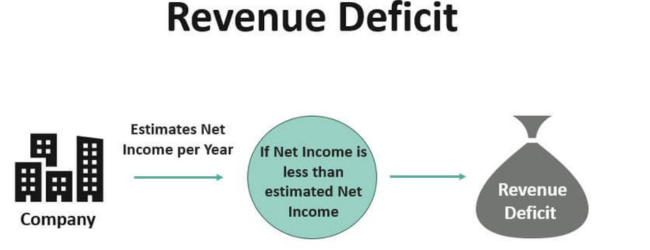Table of contents
In today’s economic environment, understanding key fiscal terms is essential not just for students but for anyone interested in how the government manages money. One such important concept is revenue deficit. It tells us whether the government is earning enough through taxes and other revenues to meet its routine expenses like salaries, subsidies, and interest payments.
What is Revenue Deficit?

In simple terms, Revenue Deficit means the shortfall between the revenue receipts and revenue expenditures of the government.
Formula:
Revenue Deficit = Revenue Expenditure – Revenue Receipts
- Revenue Expenditure: Spending on day-to-day operations like salaries, subsidies, and interest payments.
- Revenue Receipts: Income from taxes (GST, Income Tax) and non-tax revenues (dividends, interest).
Tip: Revenue deficit does not include capital expenditure, like infrastructure projects.
Causes of Revenue Deficit
Here are the major reasons why revenue deficit occurs:
1. Excessive Subsidies
- Government subsidies on food, fuel, and fertilisers are necessary but expensive.
- Example: In FY 2023-24, India spent over ₹2 lakh crore on food subsidies alone.
2. Low Tax Compliance
- Poor tax collection due to evasion, exemptions, or inefficient systems.
- India’s tax-to-GDP ratio is around 11.7%, low compared to other major economies.
3. Rising Interest Payments
- A large portion of revenue goes into paying interest on existing loans.
- FY 2024-25 budget allocates over ₹10 lakh crore for interest payments.
4. Populist Schemes & Freebies
- Schemes like farm loan waivers, free electricity, or Ujjwala gas connections increase revenue expenses.
5. Low Non-Tax Revenue
- Poor performance of public sector units (PSUs) leads to low dividend income.
ALSO READ – What Is Revenue Expenditure? Meaning, Examples & Importance
Real Examples of Revenue Deficit in India
Example 1: Union Budget 2024-25
- Revenue Receipts: ₹30.80 lakh crore
- Revenue Expenditure: ₹39.90 lakh crore
- Revenue Deficit = ₹9.10 lakh crore (approx. 2.0% of GDP)
Example 2: COVID-19 Period (2020-21)
- Revenue Deficit soared due to a collapse in tax revenue and increased welfare spending.
- It reached 4.3% of GDP, one of the highest in recent history.
Implications of Revenue Deficit

Having a persistent revenue deficit is not healthy for any economy. Here’s why:
- Increased Borrowings: To fill the gap, the government borrows more, raising the debt burden.
- Limited Capital Investment: Funds are diverted from infrastructure and growth projects.
- Inflation Risk: Higher borrowing can lead to inflation.
- Crowding Out Private Investment: Government borrowings leave less room for private sector funding.
How to Reduce Revenue Deficit?
India and other developing nations can reduce revenue deficit by taking these steps:
Increase Revenue:
- Widen tax base (e.g., include high-income professionals)
- Implement efficient GST collection and anti-evasion measures
- Boost disinvestment and dividend income from PSUs
Cut Unproductive Expenditure:
- Better targeting of subsidies (use Aadhaar, DBT)
- Control administrative and interest costs
- Rationalise welfare schemes with measurable outcomes
ALSO READ – What is Deferred Revenue? A Beginner’s Guide for Business Owners
Relevance for Students & Professionals
Understanding revenue deficit is essential for:
- Economics/Commerce students for academic and competitive exams like UPSC, CA, etc.
- Business owners need to assess their fiscal health and its impact on inflation or taxes.
- Finance professionals track fiscal trends for investment planning.
Key Takeaways
- Revenue deficit occurs when a government’s revenue expenditure exceeds its revenue receipts.
- It highlights poor fiscal discipline and indicates excessive reliance on borrowings for daily expenses.
- India’s Union Budget 2024-25 projected a revenue deficit of 2.0% of GDP, showing fiscal improvement from previous years.
- Tackling revenue deficit requires increasing tax collection, cutting non-essential spending, and promoting disinvestment.
- Understanding revenue deficit is essential for economics students, policymakers, and business professionals.
Learn more about Business skills here to unlock new growth opportunities
Need Expert Guidance?
Starting a business can be challenging, but you don’t have to do it alone! At Boss Wallah, our 2,000+ business experts are ready to provide valuable insights and guidance. Whether you need help with marketing, finance, sourcing, or any other area of your business, our business experts are here to help you succeed
Confused about Which Business to Start?
Want to start your own business but unsure which one to choose? Explore Boss Wallah, where you’ll find 500+ courses by successful business owners, featuring practical, step-by-step guides on starting and growing various businesses. Find your perfect business idea today
Conclusion
Revenue deficit is a critical economic indicator that reflects how responsibly a government manages its routine finances. While some level of deficit may be inevitable during crises or developmental stages, a sustained and high revenue deficit can hamper economic growth and lead to long-term financial stress.
India must work toward better tax compliance, efficient spending, and increased revenue generation to manage its deficit sustainably.
Explore more blogs to learn more about Business
Frequently Asked Questions (FAQs)
Revenue deficit covers current receipts vs. expenses, while fiscal deficit includes total expenditure minus total receipts (excluding borrowings).
Not always. A short-term revenue deficit during a crisis may be necessary, but a sustained deficit indicates financial mismanagement.
The Ministry of Finance, under the Union Budget, presents revenue deficit estimates.
These include tax revenue (like GST, income tax) and non-tax revenue (like interest, dividends).
Yes, but that is fiscally unhealthy. Capital receipts should fund capital expenditure, not daily operations.
Salaries, interest payments, subsidies, pensions — all are revenue expenditures.
It may lead to higher inflation, increased taxes, or reduced public services.
India’s FRBM Act targets a zero revenue deficit in the long run.
By selling the government stake in PSUs, revenue increases and reduces pressure on borrowing.
Efficient GST collection helps increase tax revenue, thus reducing the deficit.



